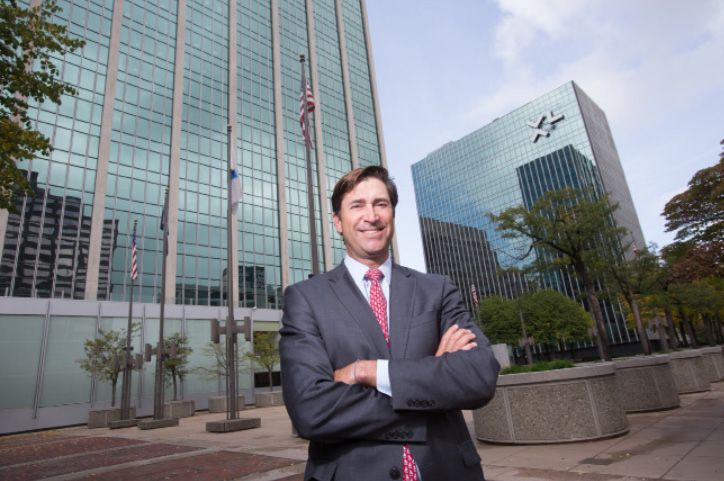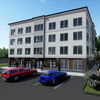Processing Your Payment
Please do not leave this page until complete. This can take a few moments.
- News
-
Editions
View Digital Editions
Biweekly Issues
- April 29, 2024
- April 15, 2024
- April 1, 2024
- March 18, 2024
- March 4, 2024
- February 19, 2024
- February 5, 2024
- January 22, 2024
- January 8, 2024
- + More
Special Editions
- Lists
- Viewpoints
- HBJ Events
- Business Calendar
- Custom Content
For region’s office market, pandemic’s impacts still lie ahead
 Credit | HBJ File Photo
Christopher Ostop is a managing director/broker of commercial realty firm Jones Lang LaSalle in Hartford.
Credit | HBJ File Photo
Christopher Ostop is a managing director/broker of commercial realty firm Jones Lang LaSalle in Hartford.
The COVID-19 pandemic has increased vacancy rates in Greater Hartford’s office market to highs not seen in years.
According to brokerage firm CBRE’s recently published fourth-quarter Hartford market report, the region’s office vacancy rate hit 20.1% at the end of 2020, the highest in over a decade.
A bright spot is that despite the pandemic, the Capital City’s rental office market posted net gains in lease absorption in 2020, which means more space was leased than abandoned. One of the largest deals during the year was Hartford HealthCare’s approximately 80,000-square-foot lease at 100 Pearl St. However, rising availability in the suburban office market more than erased the city’s gains.
On net, Greater Hartford office market tenants ceded nearly 127,000 square feet of space during 2020, according to CBRE data. For a 25.7 million-square-foot office market, that’s basically a flat year. While sluggish performance is common in the region, it may seem surprisingly resilient given the fact that the state economy is still clawing back the several hundred thousand jobs erased by the pandemic last April.
Don’t be fooled, says Michael Puzzo, a CBRE senior vice president based in Hartford. A few quarters of vacancy data doesn’t tell the whole story. The fact that commercial office leases often run for five years or more means that the pandemic’s true impacts — however mild or severe they end up being — won’t be fully measured for some time.
Even the impacts that might have been felt in 2020 have likely been delayed, as many office tenants whose leases expired last year, including the large national players that are the market’s lifeblood, opted to negotiate short-term extensions rather than make a major decision in an uncertain time.
However, 2021 should bring some more clues as to the direction of the office market over the next few years, said Puzzo, who has his money on further softening in 2021.
“Overall, we expect vacancy rates to increase and rental rates to decrease this year,” he said. “The movement in those two metrics is highly dependent on the number of large blocks of space that come back to the market."
There is more than 150,000 square feet of office space held by tenants that are requiring employees to work from home indefinitely, and many of those companies are allowing leases to expire before vacating their offices, CBRE’s fourth-quarter report said.
“Many large employers continue to have staff working from home with many timetables [of returning to the office] getting pushed out to the third or fourth quarter of 2021,” Puzzo said. “Until we see vaccines get rolled out widely, we don’t expect a substantial increase in overall occupancy levels of office buildings.”
Christopher Ostop, a managing director/broker of Jones Lang LaSalle, agrees with Puzzo that vacancies will rise further this year, as well as in 2022.
"I don’t have a crystal ball beyond that, but for sure the tenants in the market today whose leases expire in 2021 or early 2022 are actively looking to decrease their real estate,” Ostop said.
Ostop said the region’s office market was stable when 2020 began, not knowing an unforeseen virus was waiting in the wings.
“Although rents were flat, we saw strong leasing activity in 2019 headed in 2020,” he said. “We also saw new companies moving into the area, which boosts confidence and is a great story to tell.”
That includes moves announced pre-pandemic by the likes of tech companies HCL Technologies and GalaxE.Solutions Inc.
With many office tenants indicating a desire to consolidate space, Ostop laments the potential impact on Hartford. More vacancies and remote work will mean fewer daily commutes into the city, which could have a ripple effect on the local economy and the city’s overall vibrancy, not to mention on property values.
"Hartford needs increased critical mass,” he said. “In 2021 we will probably have a net decrease in leased space, which could mean less apartment rentals, less demand for retail and fewer people downtown."
Offices may look different, but they’ll stick around
While Puzzo and Ostop both predict a downturn in the office market and a potential reconfiguring and downsizing of tenant spaces, they also both wave off any predictions that office work environments are going to disappear.
“I don't believe those who are predicting the death of the office are looking at it correctly,” Puzzo said.
However, with more companies getting used to saving money on rent as workers telecommute, things are likely going to be different long term, he said. Approximately 70% of CBRE's clients across the country are planning some level of long-term, work-from-home element to their overall occupancy footprint.
“The days of having 100% of the workforce in the office five days a week from 9 to 5 could be over,” he said.
Many national office tenants are evaluating their future footprints, said Ostop, who predicts that the current mix of office-seating layouts — roughly one-third are communal or shared, known as “hoteling,” while the remainder are assigned to specific workers — could eventually flip.
“Certainly, more people will embrace the option of working remotely a day or two per week,” Ostop said. “I predict employees, if given the option, will continue to go to the office as usual three to four days per week for meetings, training and collaboration, but they will do their ‘head-down’ work remotely.”

2022 Giving Guide
This special edition informs and connects businesses with nonprofit organizations that are aligned with what they care about. Each nonprofit profile provides a crisp snapshot of the organization’s mission, goals, area of service, giving and volunteer opportunities and board leadership.
Learn more
Subscribe
Hartford Business Journal provides the top coverage of news, trends, data, politics and personalities of the area’s business community. Get the news and information you need from the award-winning writers at HBJ. Don’t miss out - subscribe today.
Subscribe
2024 Book of Lists
Delivering Vital Marketplace Content and Context to Senior Decision Makers Throughout Greater Hartford and the State ... All Year Long!
Read Here-
2022 Giving Guide
This special edition informs and connects businesses with nonprofit organizations that are aligned with what they care about. Each nonprofit profile provides a crisp snapshot of the organization’s mission, goals, area of service, giving and volunteer opportunities and board leadership.
-
Subscribe
Hartford Business Journal provides the top coverage of news, trends, data, politics and personalities of the area’s business community. Get the news and information you need from the award-winning writers at HBJ. Don’t miss out - subscribe today.
-
2024 Book of Lists
Delivering Vital Marketplace Content and Context to Senior Decision Makers Throughout Greater Hartford and the State ... All Year Long!
ABOUT
ADVERTISE
NEW ENGLAND BUSINESS MEDIA SITES
No articles left
Get access now
In order to use this feature, we need some information from you. You can also login or register for a free account.
By clicking submit you are agreeing to our cookie usage and Privacy Policy
Already have an account? Login
Already have an account? Login
Want to create an account? Register
Get access now
In order to use this feature, we need some information from you. You can also login or register for a free account.
By clicking submit you are agreeing to our cookie usage and Privacy Policy
Already have an account? Login
Already have an account? Login
Want to create an account? Register






0 Comments